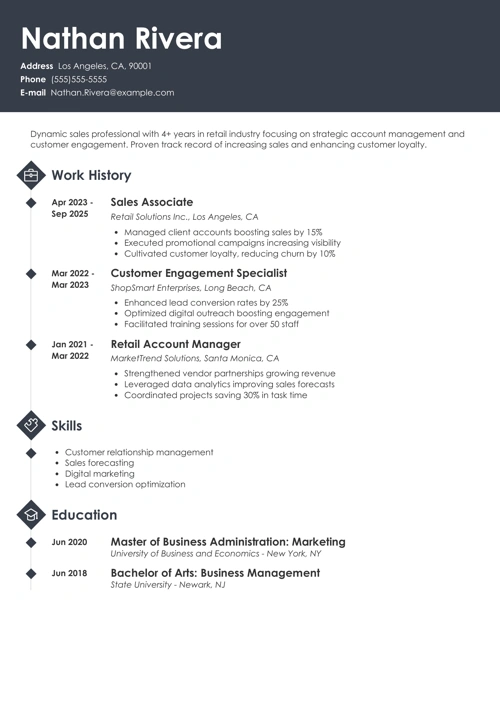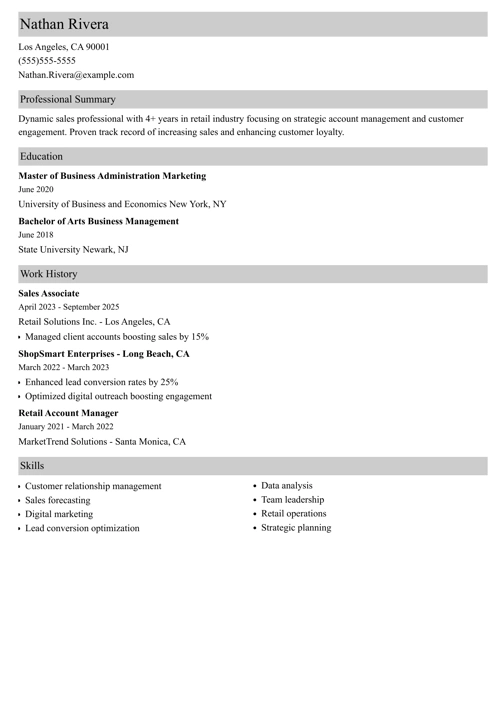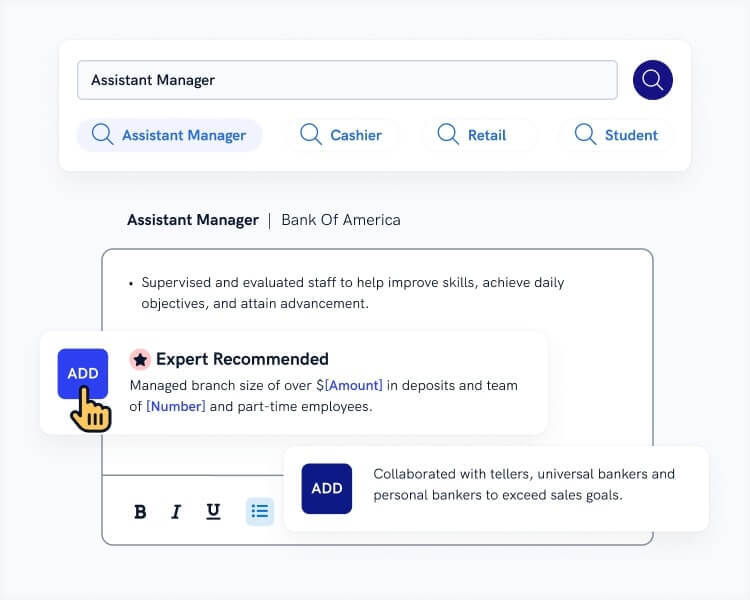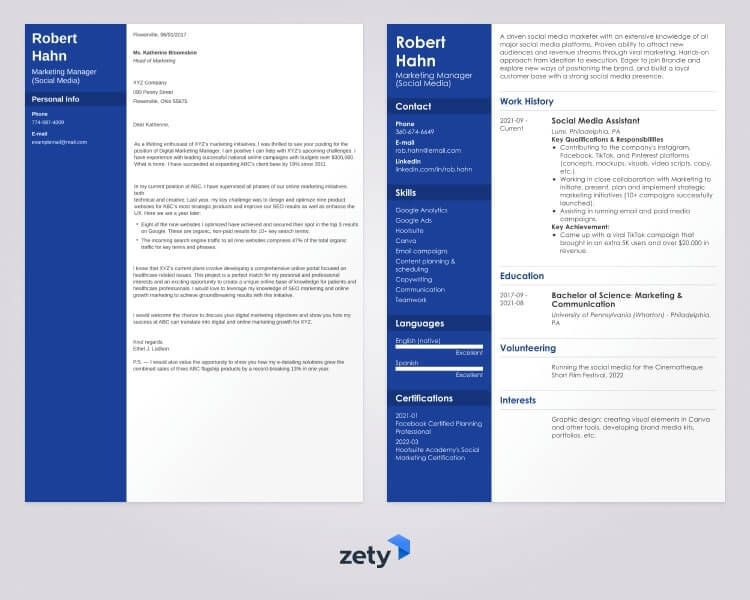People talk a lot about what a resume should say, but it can get confusing when you need to know what order to put your resume items in. Each section does something different and sometimes you just don’t know what to put your emphasis on. Should it be your skills? Or maybe your work experience is more important? As the saying goes, there’s more than one way to order a resume.
Worry not.
This quick guide will go through how to order your resume, step by step, so you’ll have your resume in running and working order in no time.
Want to save time and have your resume ready in 5 minutes? Try our AI resume builder. It’s fast and easy to use. Plus, you’ll get ready-made content to add with one click. See 20+ resume templates and create your resume here.
Sample resume made with our builder—See more resume samples here.
Here are some other guides that you can check out about getting your resume in proper, working order:
- The Best Resume Format
- The Best Resume Layouts
- The Essential Parts of a Resume
- The Correct Resume Structure
Resume Order Example
Nora Ellis
Logistics Manager
808-456-7890
noraellis@email.com
linkedin.com/in/nora.ellis
Summary
Detail-oriented Logistics Manager with 10+ years of experience. Eager to support Swift-Logistics in streamlining its logistics process and increasing efficiency by leveraging strong problem-solving skills. Reduced supply chain costs by 15% at LogiCraft by implementing a new freight management system.
Experience
Logistics Manager
LogiCraft, Pearl City, HI
May 2014–Present
Key Qualifications & Responsibilities
- Overseeing the transportation of goods from production site to consumer to client.
- Building relationships with third-party transport companies, reducing transportation delay issues by 70%.
- Leading a team of logistics specialists, winning the industry award for Best Supply Chain Initiative in 2019.
- Researching optimal transportation routes.
Key Achievement:
- Developed and implemented a new freight management system, reducing supply chain costs by 15%.
Logistics Coordinator
ShipSync, Pearl City, HI
June 2010–April 2014
Key Qualifications & Responsibilities
- Coordinated and tracked shipment plans.
- Resolved any issues regarding shipped goods.
- Ensured the timely delivery of products.
Key Achievement:
- Successfully reduced client complaints about shipments by 50%.
Education
Bachelor in Supply Chain Management
University of Hawaii, Pearl City
September 2006–May 2010
Relevant extracurricular activities
- Member of the Logistics Club
- Organized an annual event for students to meet industry professionals.
Skills
- Supply chain management
- Freight management system
- Relationship building
- Problem-solving
- Team leadership
- Time management
- Research
Certifications
- Production and Inventory Management (CPIM), APICS, 2015
Awards
- 2019, Best Supply Chain Initiative, National Logistics Association
Memberships
Member of the National Logistics Association since 2015
- Delivered a lecture on Efficient Freight Management during the 2018 National Logistics Conference, Pearl City.
Languages
- English—Native
- Spanish—Intermediate
Interests
- Volunteering at the local food bank.
- Mentoring young professionals in logistics management.
How to Organize a Resume
Before we begin, let’s do a short recap of what the sections of your resume are before we start to put them in order.
For the majority of candidates, the popular resume items are:
- Contact Information
- Resume Profile (Objective/Summary)
- Work Experience
- Education
- Skills
- Additional Sections
Now it’s time to organize your resume into the correct order.
Let’s start off with making one distinction clear—
There are three different types of ways to order your resume and that, of course, causes lots of candidates to go all Avril Lavigne by shouting “why did you have to go and make things so complicated?”
What order should work experience be listed on a resume?
Work experience should always be listed on a resume in reverse chronological order. Your work history should go back in time from top to bottom: your current or most recent job on top, then the previous one below, all the way to the odest, but still relevant job.
Making a resume with our builder is incredibly simple. Follow our step-by-step guide, use ready-made content tailored to your job and have a resume ready in minutes.
When you’re done, our AI resume builder will score your resume and our resume checker will show you exactly how to improve it.
Three Ways of Ordering Your Resume
It may sound complicated, but let’s break it down and you’ll see that it’s actually relatively simple.
1. The Reverse-Chronological Order
This resume order is by far the most common among candidates and most recognized by recruiters. It also goes by the name of chronological order. So as confusing as it may be, the reverse-chronological resume and the chronological resume are the same thing.
This order focuses on your skills and professional work experience, so it’s the best for candidates with at least some job experience under their belt.
The name comes from the fact that you start with your most recent job position and goes backwards in time.
This is what a reverse-chronological resume order looks like:
- Contact Infromation
- Resume Objective/Summary
- Work Experience
- Education
- Skills
- Additional Sections
Read more: The Reverse-Chronological Resume (Template and Examples)
2. The Functional/Skill-Based Resume Order
The functional resume, also called the skills-based resume, puts more emphasis on your skills than anything else. It’s perfect for candidates that switched jobs a lot, did a lot of freelancing or who have a lot of career gaps in their work history. It’s a good creative resume format for non-traditional industries, too.
This is what the functional resume order looks like:
- Contact Information
- Resume Summary/Objective
- Skills Section
- Work Experience
- Education
- Additional Sections
Read more: Functional Resume: Template
3. The Combination Resume Order
The combination resume order is a combination of the reverse-chronological and functional resume orders. It focuses on the summary of your qualifications, so it’s best for career changer resumes or for more experienced candidates.
This is how the combination resume order breaks down:
- Contact Information
- Skills Summary
- Work Experience
- Education
- Additional Sections
Read more: The Combination Resume: Template and Examples
See, wasn’t all that complicated, was it?
Now that that’s clear, let’s take closer look at how to order the different, individual items of your resume:
Resume Order of Items
- Resume objective or resume summary: This is a short blurb about your experience and skill set and should be no longer than 2-3 sentences. It goes at the top of your resume.
- Resume experience order: no matter which type of resume order you choose, you should always order your jobs reverse-chronologically on your resume. Start from the most recent position and work your way backwards.
- Job skills: there’s no right way to order your skills, just simply list them. If you have a lot of them, you can think of putting them into subgroups to make them easier to read. Remember to include a good mix of soft skills, hard skills as well as technical skills.
- Education: when listing your education on a resume, the simplest and most common order is listing the name of your school, the school’s location, the dates you attended, and the degree you earned. Listing unfinished college on a resume is similar, you just leave out the degree and potentially add relevant college courses. Remember to start your education section with your most recent degree level.
- Additional sections: here you can list things like projects, achievements and accomplishments, licenses and certificates, volunteering, hobbies and interests, and languages. These are often overlooked and that’s a shame as they can be a key factor in finding certain types of jobs.
Pro Tip: No matter how you order your resume, remember to stick to the truth. Recruiters do background checks and will ask for proof of education or skills if checks come up empty.
Read more: How to Write a Resume
Plus, a great cover letter that matches your resume will give you an advantage over other candidates. You can write it in our cover letter builder here. Here's what it may look like:
See more cover letter templates and start writing.
That’s all there is to it! Get the parts of your resume in working order and watch it zoom down the road of success!
About Zety’s Editorial Process
This article has been reviewed by our editorial team to make sure it follows Zety's editorial guidelines. We’re committed to sharing our expertise and giving you trustworthy career advice tailored to your needs. High-quality content is what brings over 40 million readers to our site every year. But we don't stop there. Our team conducts original research to understand the job market better, and we pride ourselves on being quoted by top universities and prime media outlets from around the world.




